Managerial Accounting: Financial Analysis of Angel Seafood Holdings
VerifiedAdded on 2023/04/21
|20
|4415
|121
Report
AI Summary
This report provides a financial performance analysis of Angel Seafood Holdings Limited for 2018, including estimations of future performance and an evaluation of top-down and bottom-up budgeting approaches. It includes a budgeted income statement for 2019 and a comparison with the actual 2018 statement. The report assesses the elements of a master budget and concludes that a top-down approach is more suitable for Angel Seafood Holdings, enabling the firm to develop necessary budgets to support its operations and formulate required income levels.
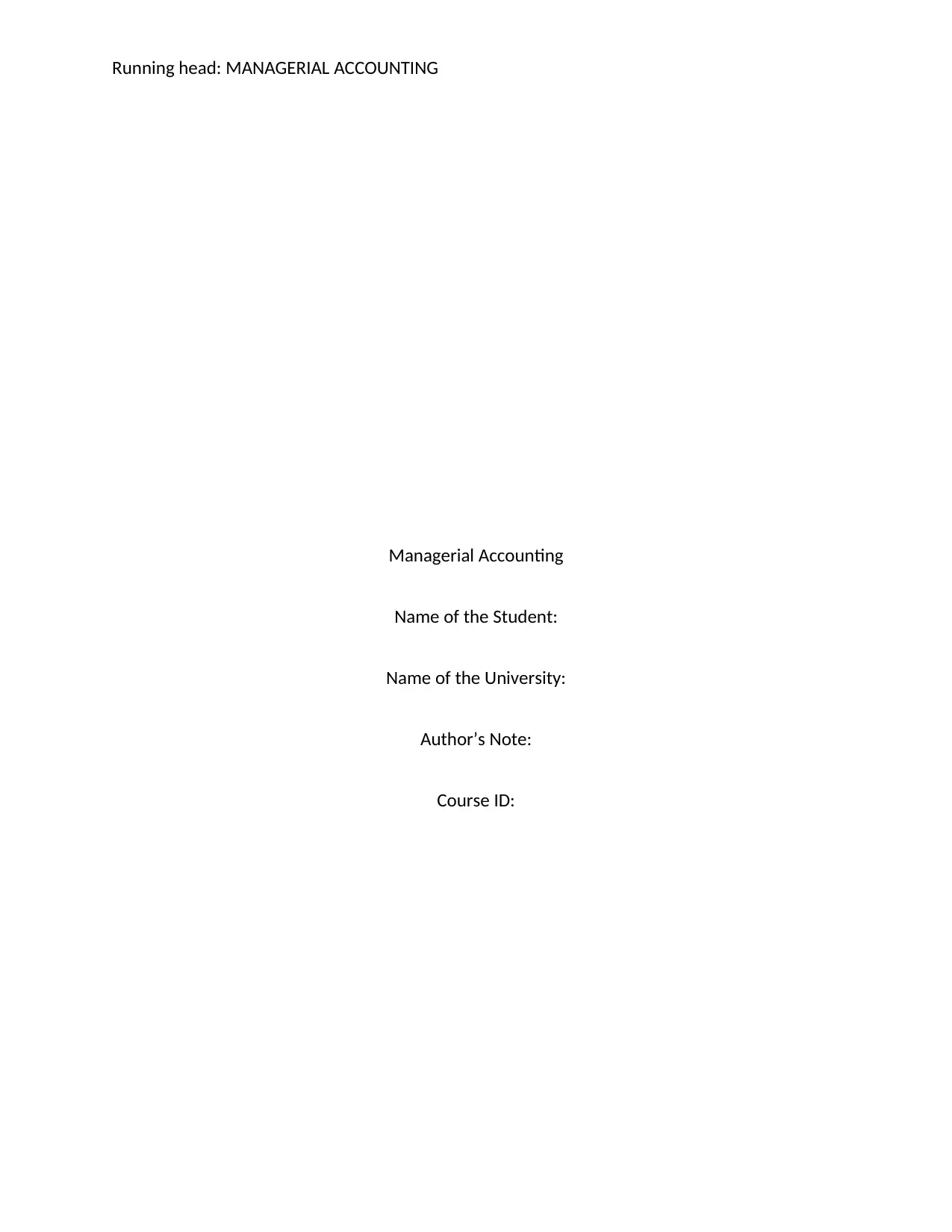
Running head: MANAGERIAL ACCOUNTING
Managerial Accounting
Name of the Student:
Name of the University:
Author’s Note:
Course ID:
Managerial Accounting
Name of the Student:
Name of the University:
Author’s Note:
Course ID:
Paraphrase This Document
Need a fresh take? Get an instant paraphrase of this document with our AI Paraphraser
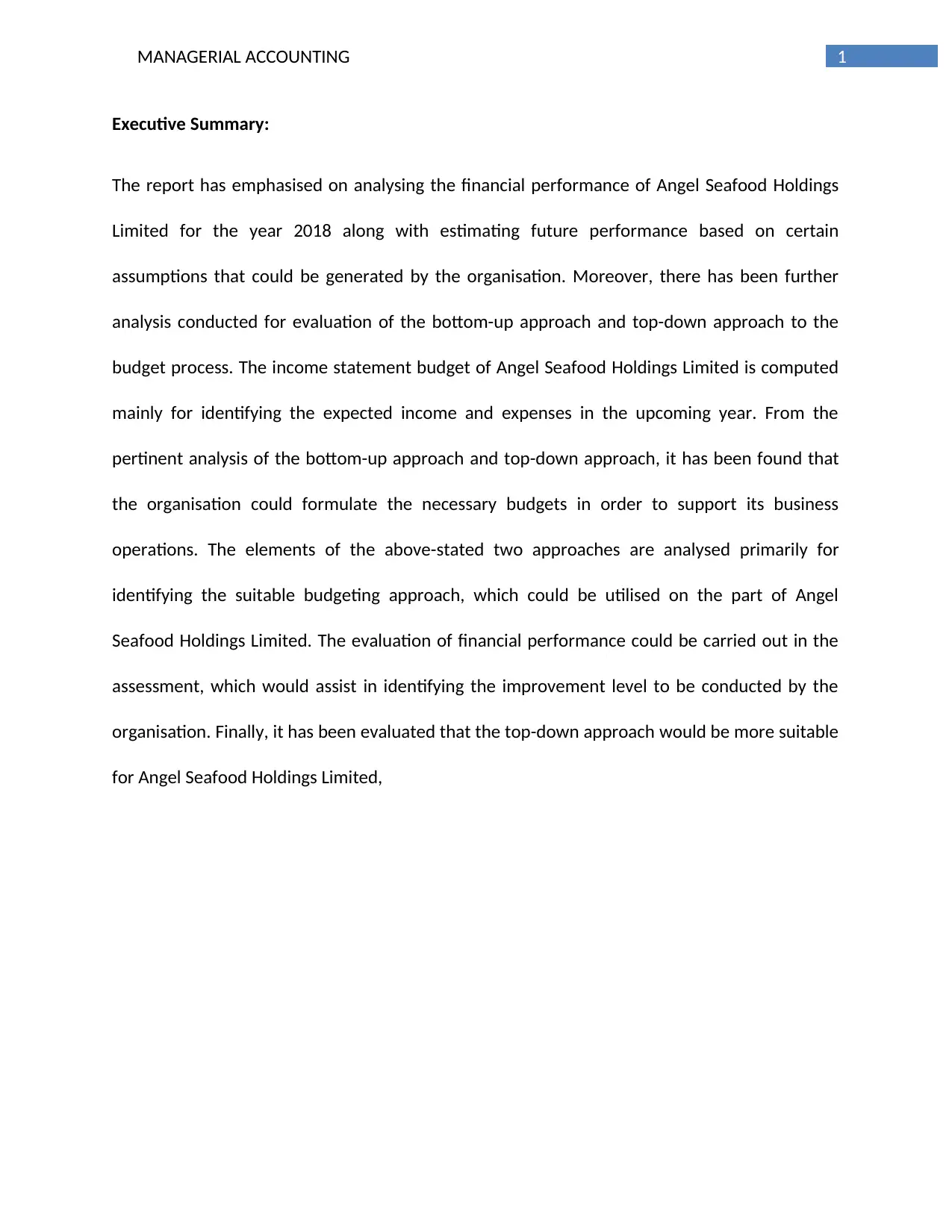
1MANAGERIAL ACCOUNTING
Executive Summary:
The report has emphasised on analysing the financial performance of Angel Seafood Holdings
Limited for the year 2018 along with estimating future performance based on certain
assumptions that could be generated by the organisation. Moreover, there has been further
analysis conducted for evaluation of the bottom-up approach and top-down approach to the
budget process. The income statement budget of Angel Seafood Holdings Limited is computed
mainly for identifying the expected income and expenses in the upcoming year. From the
pertinent analysis of the bottom-up approach and top-down approach, it has been found that
the organisation could formulate the necessary budgets in order to support its business
operations. The elements of the above-stated two approaches are analysed primarily for
identifying the suitable budgeting approach, which could be utilised on the part of Angel
Seafood Holdings Limited. The evaluation of financial performance could be carried out in the
assessment, which would assist in identifying the improvement level to be conducted by the
organisation. Finally, it has been evaluated that the top-down approach would be more suitable
for Angel Seafood Holdings Limited,
Executive Summary:
The report has emphasised on analysing the financial performance of Angel Seafood Holdings
Limited for the year 2018 along with estimating future performance based on certain
assumptions that could be generated by the organisation. Moreover, there has been further
analysis conducted for evaluation of the bottom-up approach and top-down approach to the
budget process. The income statement budget of Angel Seafood Holdings Limited is computed
mainly for identifying the expected income and expenses in the upcoming year. From the
pertinent analysis of the bottom-up approach and top-down approach, it has been found that
the organisation could formulate the necessary budgets in order to support its business
operations. The elements of the above-stated two approaches are analysed primarily for
identifying the suitable budgeting approach, which could be utilised on the part of Angel
Seafood Holdings Limited. The evaluation of financial performance could be carried out in the
assessment, which would assist in identifying the improvement level to be conducted by the
organisation. Finally, it has been evaluated that the top-down approach would be more suitable
for Angel Seafood Holdings Limited,
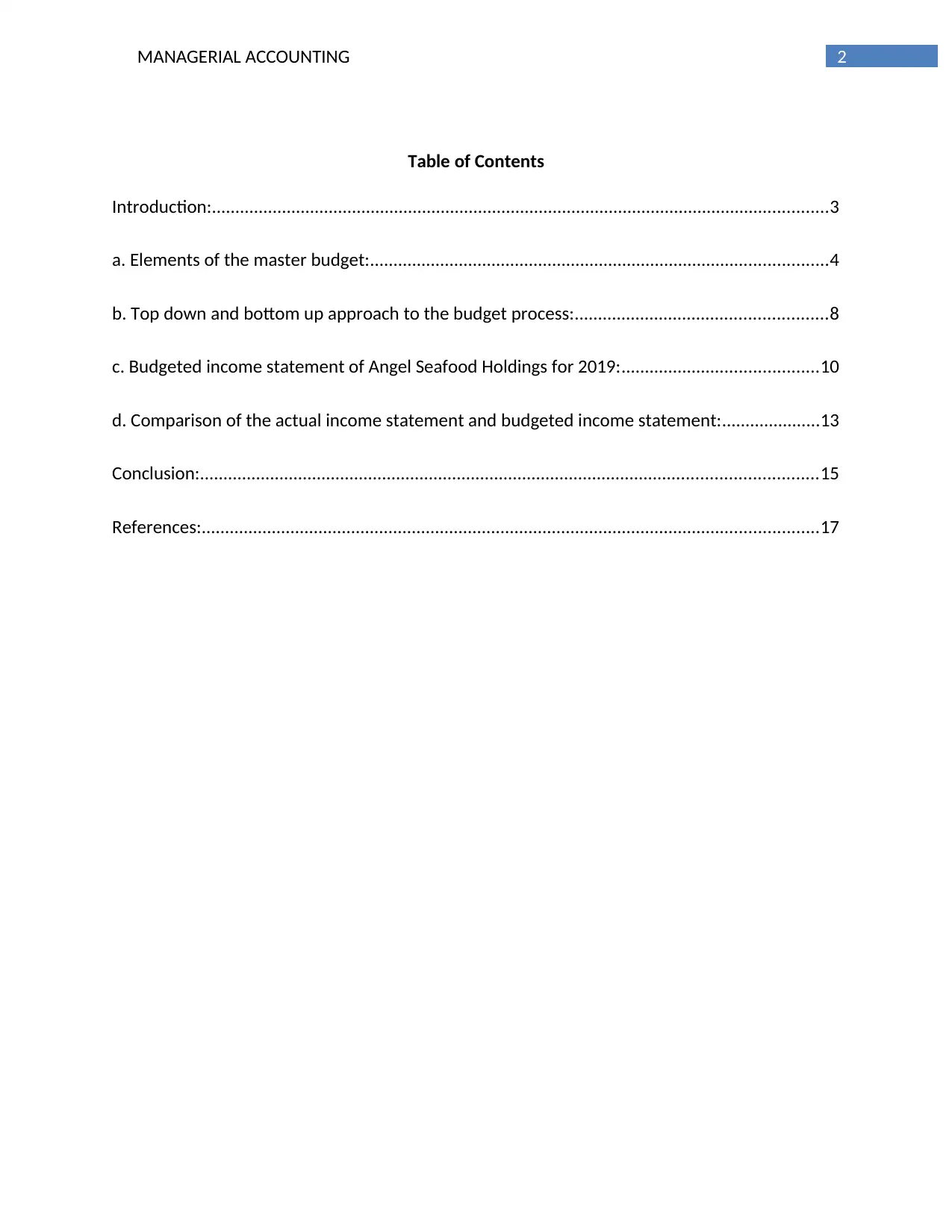
2MANAGERIAL ACCOUNTING
Table of Contents
Introduction:....................................................................................................................................3
a. Elements of the master budget:..................................................................................................4
b. Top down and bottom up approach to the budget process:......................................................8
c. Budgeted income statement of Angel Seafood Holdings for 2019:..........................................10
d. Comparison of the actual income statement and budgeted income statement:.....................13
Conclusion:....................................................................................................................................15
References:....................................................................................................................................17
Table of Contents
Introduction:....................................................................................................................................3
a. Elements of the master budget:..................................................................................................4
b. Top down and bottom up approach to the budget process:......................................................8
c. Budgeted income statement of Angel Seafood Holdings for 2019:..........................................10
d. Comparison of the actual income statement and budgeted income statement:.....................13
Conclusion:....................................................................................................................................15
References:....................................................................................................................................17
⊘ This is a preview!⊘
Do you want full access?
Subscribe today to unlock all pages.

Trusted by 1+ million students worldwide
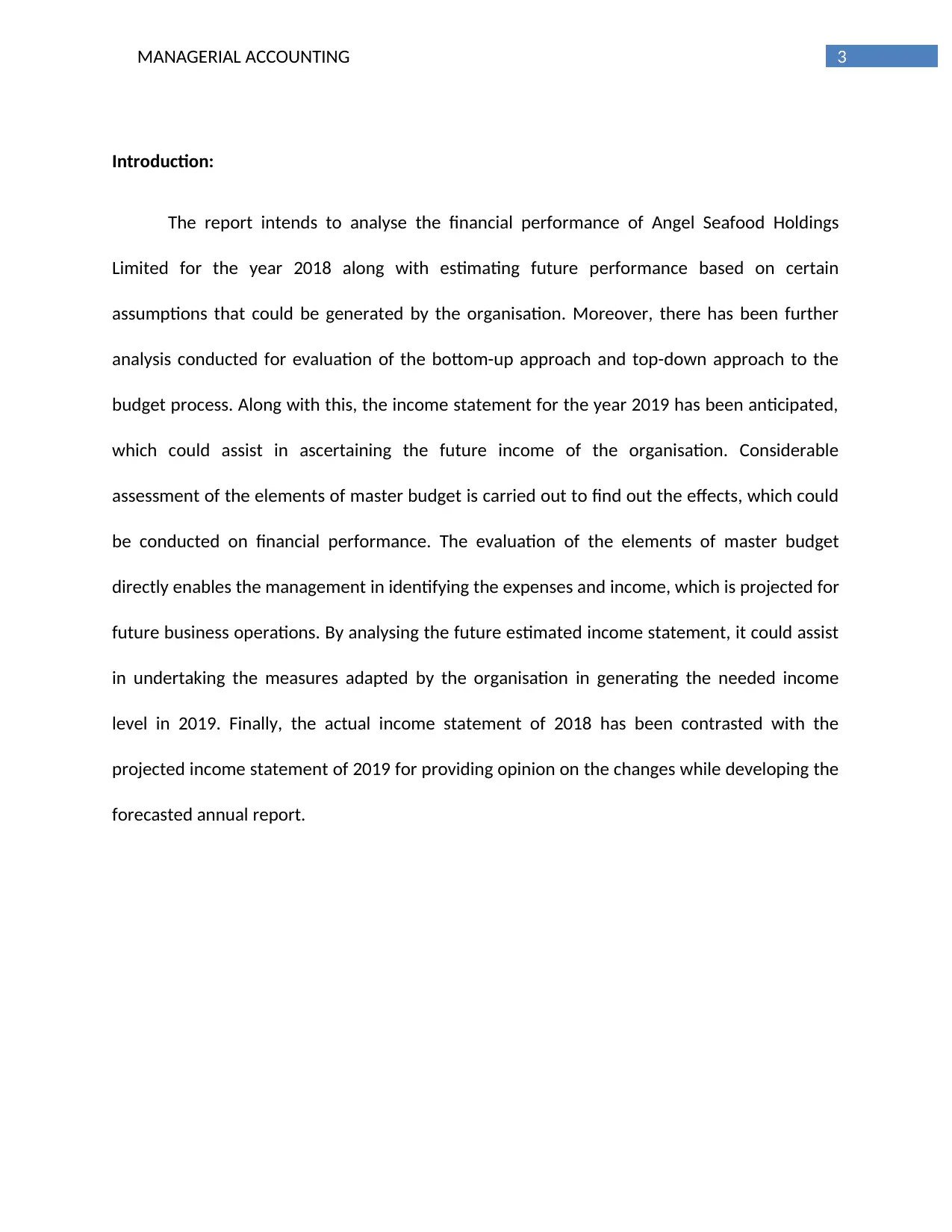
3MANAGERIAL ACCOUNTING
Introduction:
The report intends to analyse the financial performance of Angel Seafood Holdings
Limited for the year 2018 along with estimating future performance based on certain
assumptions that could be generated by the organisation. Moreover, there has been further
analysis conducted for evaluation of the bottom-up approach and top-down approach to the
budget process. Along with this, the income statement for the year 2019 has been anticipated,
which could assist in ascertaining the future income of the organisation. Considerable
assessment of the elements of master budget is carried out to find out the effects, which could
be conducted on financial performance. The evaluation of the elements of master budget
directly enables the management in identifying the expenses and income, which is projected for
future business operations. By analysing the future estimated income statement, it could assist
in undertaking the measures adapted by the organisation in generating the needed income
level in 2019. Finally, the actual income statement of 2018 has been contrasted with the
projected income statement of 2019 for providing opinion on the changes while developing the
forecasted annual report.
Introduction:
The report intends to analyse the financial performance of Angel Seafood Holdings
Limited for the year 2018 along with estimating future performance based on certain
assumptions that could be generated by the organisation. Moreover, there has been further
analysis conducted for evaluation of the bottom-up approach and top-down approach to the
budget process. Along with this, the income statement for the year 2019 has been anticipated,
which could assist in ascertaining the future income of the organisation. Considerable
assessment of the elements of master budget is carried out to find out the effects, which could
be conducted on financial performance. The evaluation of the elements of master budget
directly enables the management in identifying the expenses and income, which is projected for
future business operations. By analysing the future estimated income statement, it could assist
in undertaking the measures adapted by the organisation in generating the needed income
level in 2019. Finally, the actual income statement of 2018 has been contrasted with the
projected income statement of 2019 for providing opinion on the changes while developing the
forecasted annual report.
Paraphrase This Document
Need a fresh take? Get an instant paraphrase of this document with our AI Paraphraser
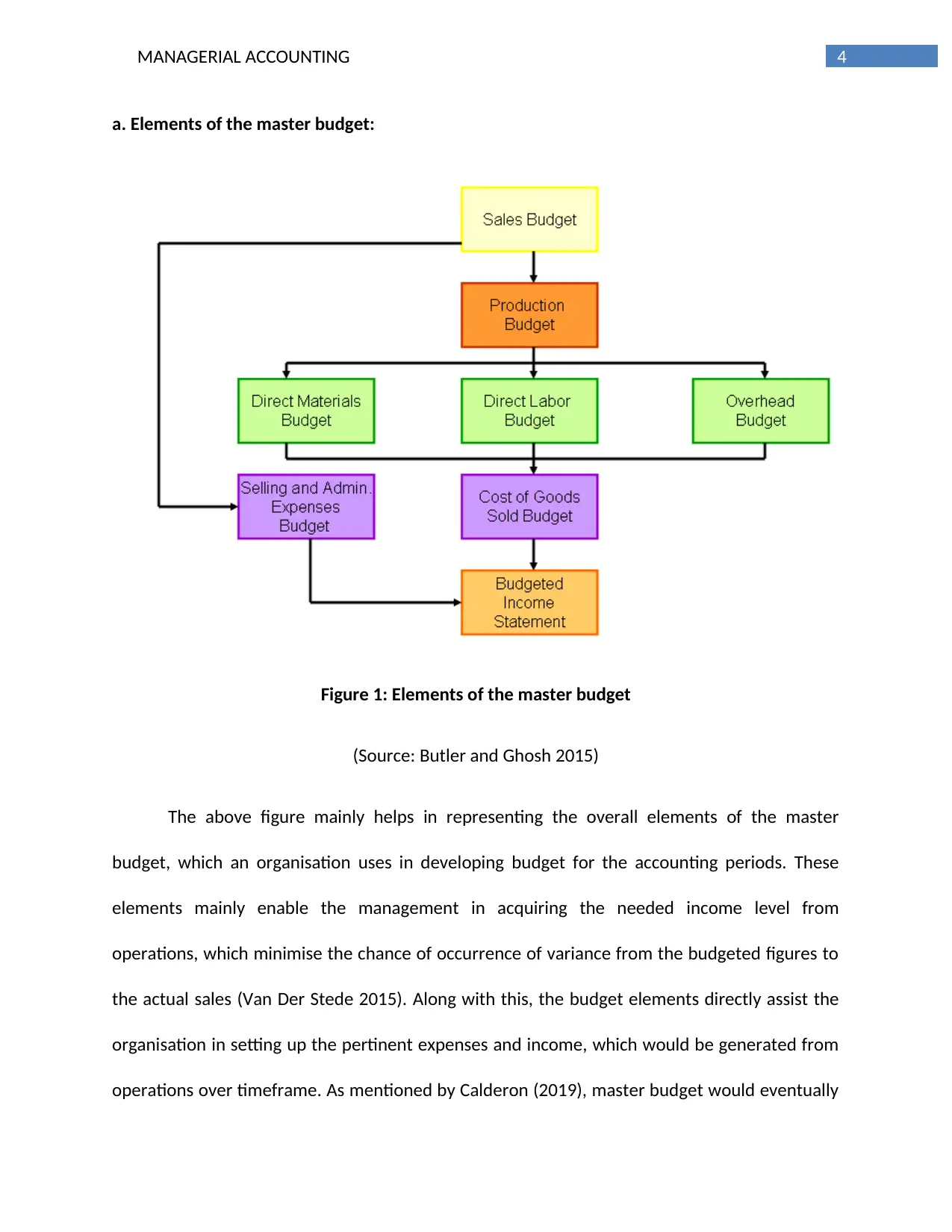
4MANAGERIAL ACCOUNTING
a. Elements of the master budget:
Figure 1: Elements of the master budget
(Source: Butler and Ghosh 2015)
The above figure mainly helps in representing the overall elements of the master
budget, which an organisation uses in developing budget for the accounting periods. These
elements mainly enable the management in acquiring the needed income level from
operations, which minimise the chance of occurrence of variance from the budgeted figures to
the actual sales (Van Der Stede 2015). Along with this, the budget elements directly assist the
organisation in setting up the pertinent expenses and income, which would be generated from
operations over timeframe. As mentioned by Calderon (2019), master budget would eventually
a. Elements of the master budget:
Figure 1: Elements of the master budget
(Source: Butler and Ghosh 2015)
The above figure mainly helps in representing the overall elements of the master
budget, which an organisation uses in developing budget for the accounting periods. These
elements mainly enable the management in acquiring the needed income level from
operations, which minimise the chance of occurrence of variance from the budgeted figures to
the actual sales (Van Der Stede 2015). Along with this, the budget elements directly assist the
organisation in setting up the pertinent expenses and income, which would be generated from
operations over timeframe. As mentioned by Calderon (2019), master budget would eventually
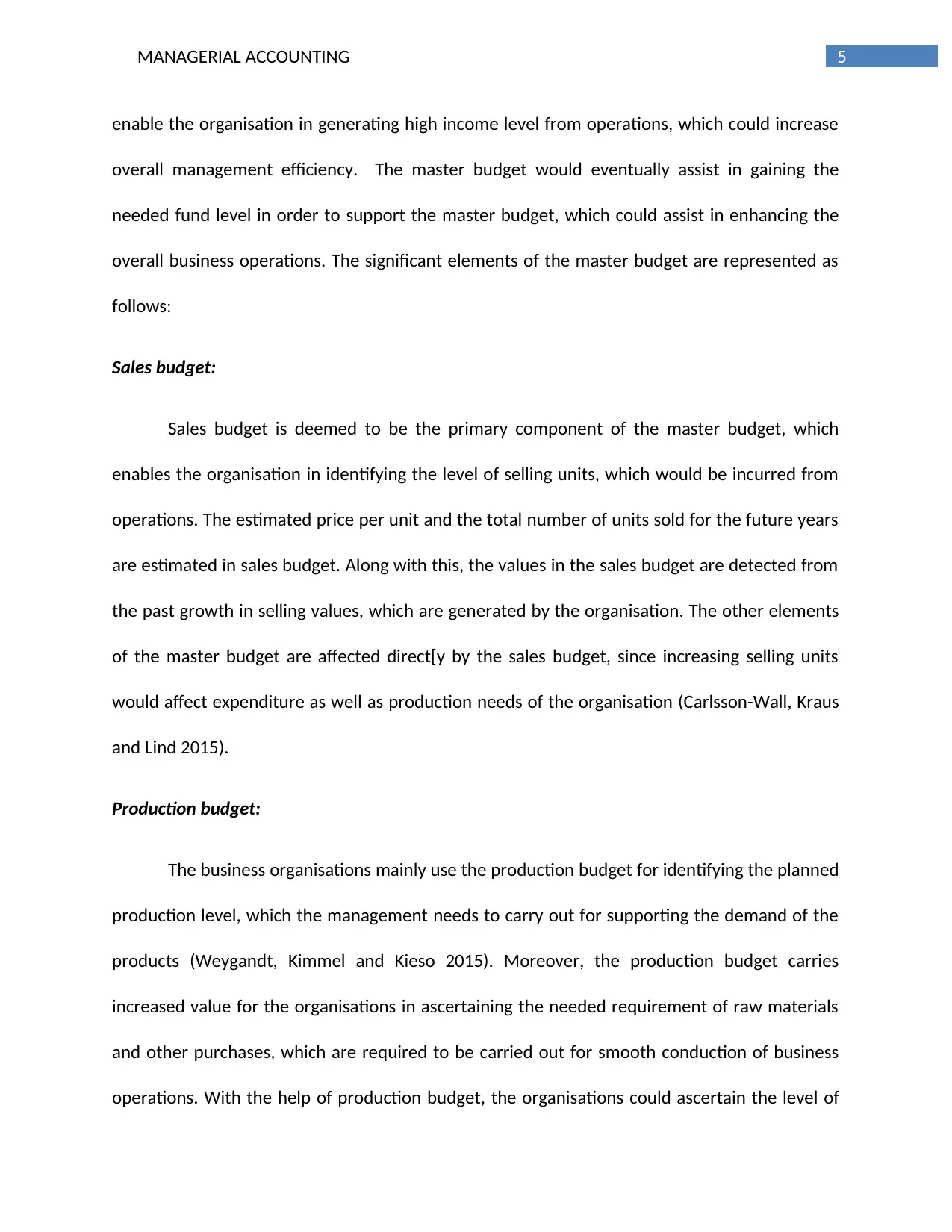
5MANAGERIAL ACCOUNTING
enable the organisation in generating high income level from operations, which could increase
overall management efficiency. The master budget would eventually assist in gaining the
needed fund level in order to support the master budget, which could assist in enhancing the
overall business operations. The significant elements of the master budget are represented as
follows:
Sales budget:
Sales budget is deemed to be the primary component of the master budget, which
enables the organisation in identifying the level of selling units, which would be incurred from
operations. The estimated price per unit and the total number of units sold for the future years
are estimated in sales budget. Along with this, the values in the sales budget are detected from
the past growth in selling values, which are generated by the organisation. The other elements
of the master budget are affected direct[y by the sales budget, since increasing selling units
would affect expenditure as well as production needs of the organisation (Carlsson-Wall, Kraus
and Lind 2015).
Production budget:
The business organisations mainly use the production budget for identifying the planned
production level, which the management needs to carry out for supporting the demand of the
products (Weygandt, Kimmel and Kieso 2015). Moreover, the production budget carries
increased value for the organisations in ascertaining the needed requirement of raw materials
and other purchases, which are required to be carried out for smooth conduction of business
operations. With the help of production budget, the organisations could ascertain the level of
enable the organisation in generating high income level from operations, which could increase
overall management efficiency. The master budget would eventually assist in gaining the
needed fund level in order to support the master budget, which could assist in enhancing the
overall business operations. The significant elements of the master budget are represented as
follows:
Sales budget:
Sales budget is deemed to be the primary component of the master budget, which
enables the organisation in identifying the level of selling units, which would be incurred from
operations. The estimated price per unit and the total number of units sold for the future years
are estimated in sales budget. Along with this, the values in the sales budget are detected from
the past growth in selling values, which are generated by the organisation. The other elements
of the master budget are affected direct[y by the sales budget, since increasing selling units
would affect expenditure as well as production needs of the organisation (Carlsson-Wall, Kraus
and Lind 2015).
Production budget:
The business organisations mainly use the production budget for identifying the planned
production level, which the management needs to carry out for supporting the demand of the
products (Weygandt, Kimmel and Kieso 2015). Moreover, the production budget carries
increased value for the organisations in ascertaining the needed requirement of raw materials
and other purchases, which are required to be carried out for smooth conduction of business
operations. With the help of production budget, the organisations could ascertain the level of
⊘ This is a preview!⊘
Do you want full access?
Subscribe today to unlock all pages.

Trusted by 1+ million students worldwide
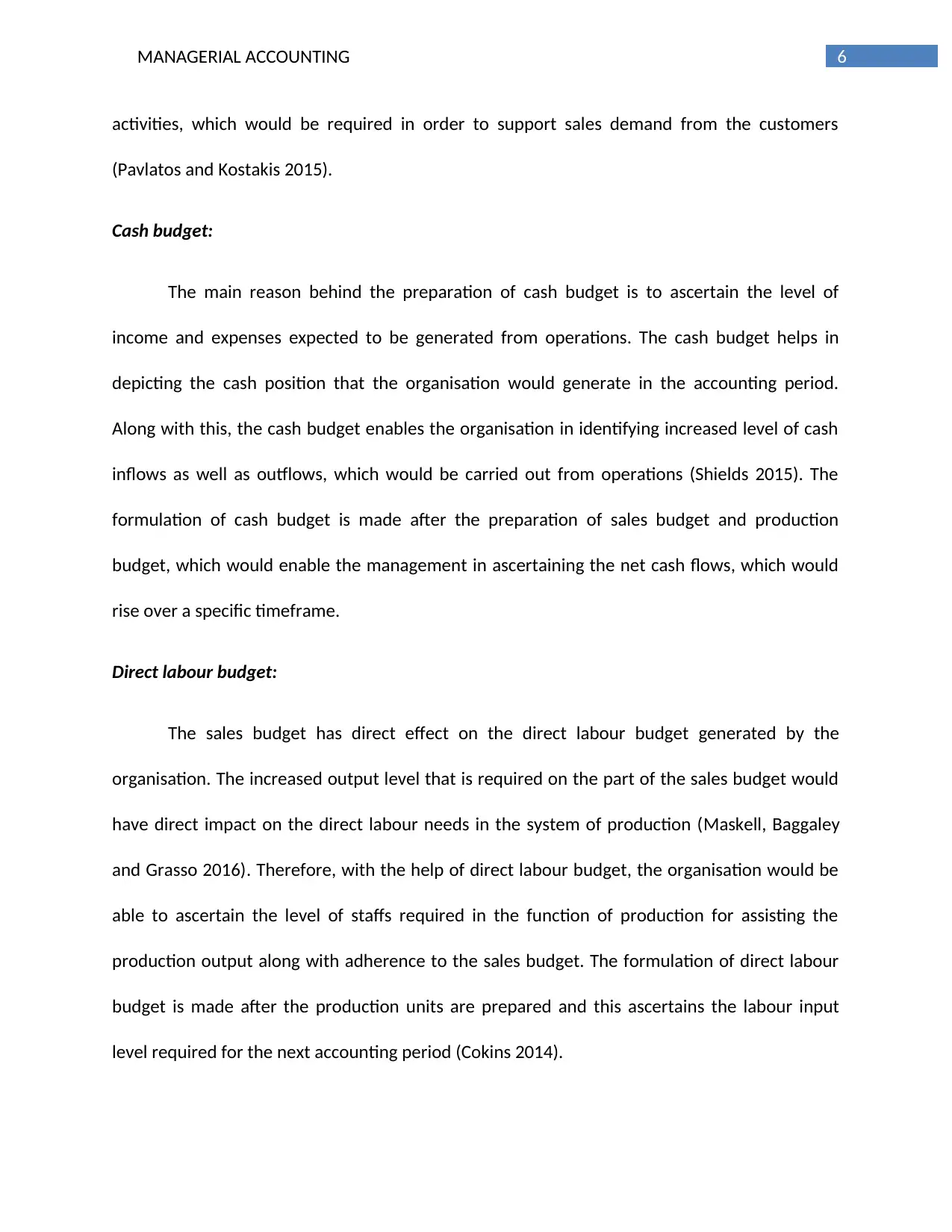
6MANAGERIAL ACCOUNTING
activities, which would be required in order to support sales demand from the customers
(Pavlatos and Kostakis 2015).
Cash budget:
The main reason behind the preparation of cash budget is to ascertain the level of
income and expenses expected to be generated from operations. The cash budget helps in
depicting the cash position that the organisation would generate in the accounting period.
Along with this, the cash budget enables the organisation in identifying increased level of cash
inflows as well as outflows, which would be carried out from operations (Shields 2015). The
formulation of cash budget is made after the preparation of sales budget and production
budget, which would enable the management in ascertaining the net cash flows, which would
rise over a specific timeframe.
Direct labour budget:
The sales budget has direct effect on the direct labour budget generated by the
organisation. The increased output level that is required on the part of the sales budget would
have direct impact on the direct labour needs in the system of production (Maskell, Baggaley
and Grasso 2016). Therefore, with the help of direct labour budget, the organisation would be
able to ascertain the level of staffs required in the function of production for assisting the
production output along with adherence to the sales budget. The formulation of direct labour
budget is made after the production units are prepared and this ascertains the labour input
level required for the next accounting period (Cokins 2014).
activities, which would be required in order to support sales demand from the customers
(Pavlatos and Kostakis 2015).
Cash budget:
The main reason behind the preparation of cash budget is to ascertain the level of
income and expenses expected to be generated from operations. The cash budget helps in
depicting the cash position that the organisation would generate in the accounting period.
Along with this, the cash budget enables the organisation in identifying increased level of cash
inflows as well as outflows, which would be carried out from operations (Shields 2015). The
formulation of cash budget is made after the preparation of sales budget and production
budget, which would enable the management in ascertaining the net cash flows, which would
rise over a specific timeframe.
Direct labour budget:
The sales budget has direct effect on the direct labour budget generated by the
organisation. The increased output level that is required on the part of the sales budget would
have direct impact on the direct labour needs in the system of production (Maskell, Baggaley
and Grasso 2016). Therefore, with the help of direct labour budget, the organisation would be
able to ascertain the level of staffs required in the function of production for assisting the
production output along with adherence to the sales budget. The formulation of direct labour
budget is made after the production units are prepared and this ascertains the labour input
level required for the next accounting period (Cokins 2014).
Paraphrase This Document
Need a fresh take? Get an instant paraphrase of this document with our AI Paraphraser
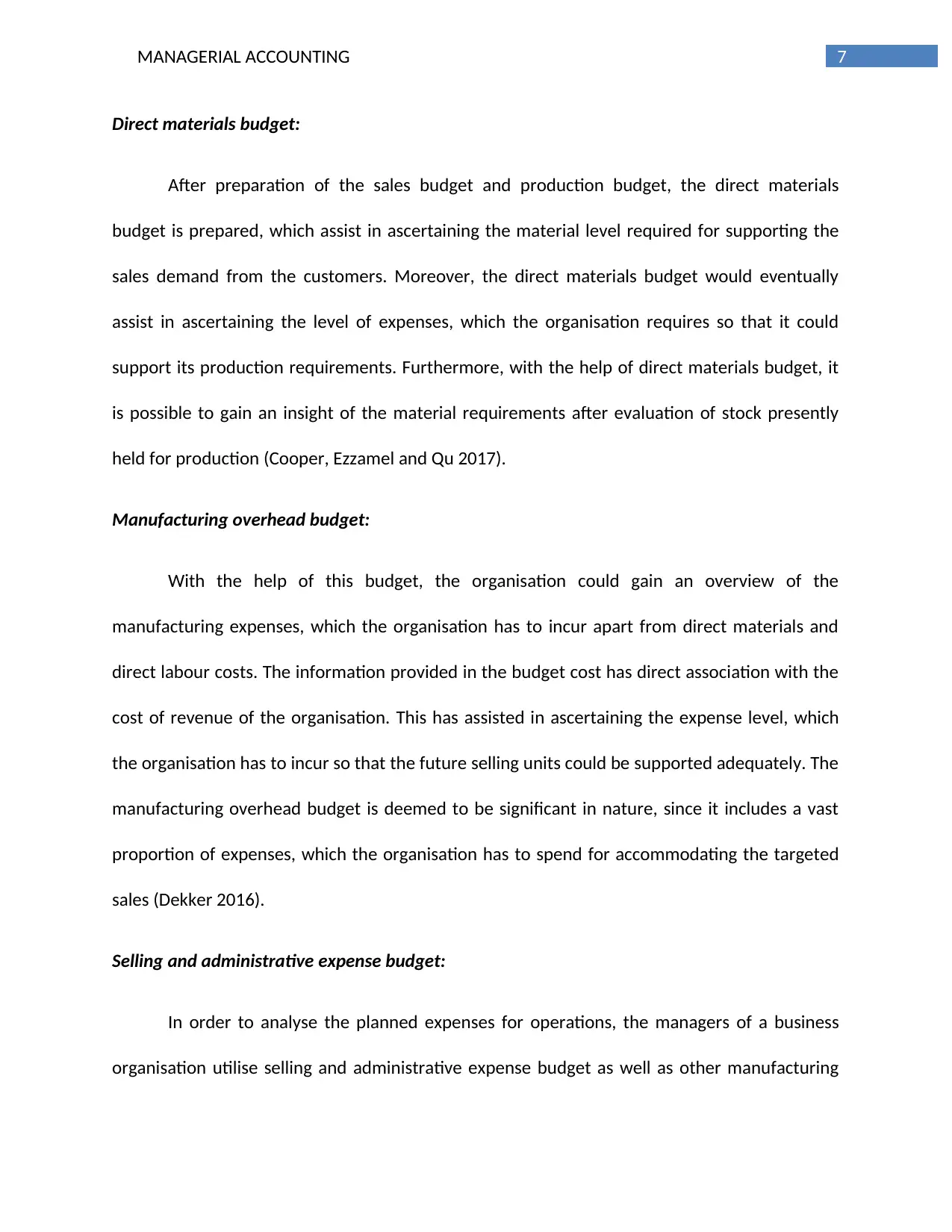
7MANAGERIAL ACCOUNTING
Direct materials budget:
After preparation of the sales budget and production budget, the direct materials
budget is prepared, which assist in ascertaining the material level required for supporting the
sales demand from the customers. Moreover, the direct materials budget would eventually
assist in ascertaining the level of expenses, which the organisation requires so that it could
support its production requirements. Furthermore, with the help of direct materials budget, it
is possible to gain an insight of the material requirements after evaluation of stock presently
held for production (Cooper, Ezzamel and Qu 2017).
Manufacturing overhead budget:
With the help of this budget, the organisation could gain an overview of the
manufacturing expenses, which the organisation has to incur apart from direct materials and
direct labour costs. The information provided in the budget cost has direct association with the
cost of revenue of the organisation. This has assisted in ascertaining the expense level, which
the organisation has to incur so that the future selling units could be supported adequately. The
manufacturing overhead budget is deemed to be significant in nature, since it includes a vast
proportion of expenses, which the organisation has to spend for accommodating the targeted
sales (Dekker 2016).
Selling and administrative expense budget:
In order to analyse the planned expenses for operations, the managers of a business
organisation utilise selling and administrative expense budget as well as other manufacturing
Direct materials budget:
After preparation of the sales budget and production budget, the direct materials
budget is prepared, which assist in ascertaining the material level required for supporting the
sales demand from the customers. Moreover, the direct materials budget would eventually
assist in ascertaining the level of expenses, which the organisation requires so that it could
support its production requirements. Furthermore, with the help of direct materials budget, it
is possible to gain an insight of the material requirements after evaluation of stock presently
held for production (Cooper, Ezzamel and Qu 2017).
Manufacturing overhead budget:
With the help of this budget, the organisation could gain an overview of the
manufacturing expenses, which the organisation has to incur apart from direct materials and
direct labour costs. The information provided in the budget cost has direct association with the
cost of revenue of the organisation. This has assisted in ascertaining the expense level, which
the organisation has to incur so that the future selling units could be supported adequately. The
manufacturing overhead budget is deemed to be significant in nature, since it includes a vast
proportion of expenses, which the organisation has to spend for accommodating the targeted
sales (Dekker 2016).
Selling and administrative expense budget:
In order to analyse the planned expenses for operations, the managers of a business
organisation utilise selling and administrative expense budget as well as other manufacturing
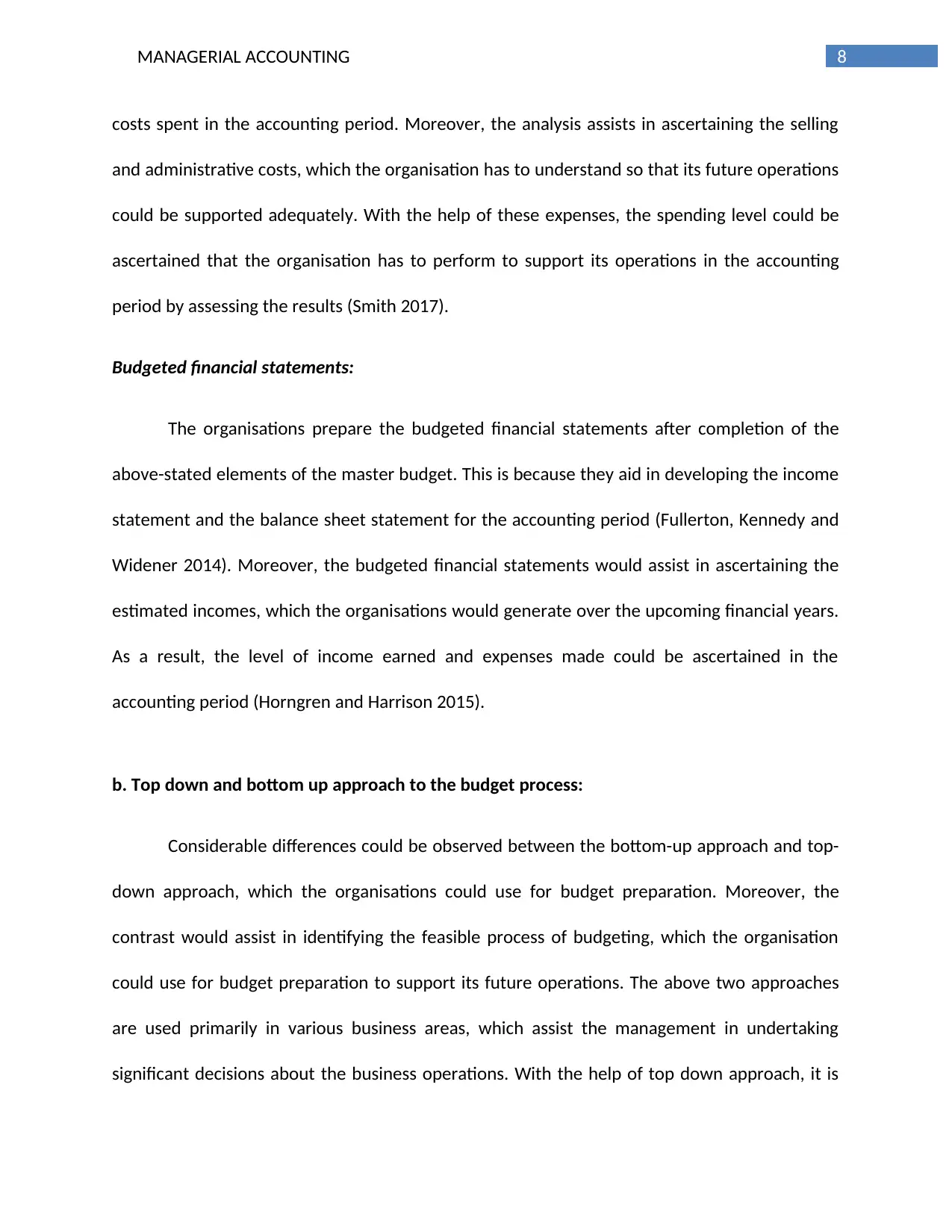
8MANAGERIAL ACCOUNTING
costs spent in the accounting period. Moreover, the analysis assists in ascertaining the selling
and administrative costs, which the organisation has to understand so that its future operations
could be supported adequately. With the help of these expenses, the spending level could be
ascertained that the organisation has to perform to support its operations in the accounting
period by assessing the results (Smith 2017).
Budgeted financial statements:
The organisations prepare the budgeted financial statements after completion of the
above-stated elements of the master budget. This is because they aid in developing the income
statement and the balance sheet statement for the accounting period (Fullerton, Kennedy and
Widener 2014). Moreover, the budgeted financial statements would assist in ascertaining the
estimated incomes, which the organisations would generate over the upcoming financial years.
As a result, the level of income earned and expenses made could be ascertained in the
accounting period (Horngren and Harrison 2015).
b. Top down and bottom up approach to the budget process:
Considerable differences could be observed between the bottom-up approach and top-
down approach, which the organisations could use for budget preparation. Moreover, the
contrast would assist in identifying the feasible process of budgeting, which the organisation
could use for budget preparation to support its future operations. The above two approaches
are used primarily in various business areas, which assist the management in undertaking
significant decisions about the business operations. With the help of top down approach, it is
costs spent in the accounting period. Moreover, the analysis assists in ascertaining the selling
and administrative costs, which the organisation has to understand so that its future operations
could be supported adequately. With the help of these expenses, the spending level could be
ascertained that the organisation has to perform to support its operations in the accounting
period by assessing the results (Smith 2017).
Budgeted financial statements:
The organisations prepare the budgeted financial statements after completion of the
above-stated elements of the master budget. This is because they aid in developing the income
statement and the balance sheet statement for the accounting period (Fullerton, Kennedy and
Widener 2014). Moreover, the budgeted financial statements would assist in ascertaining the
estimated incomes, which the organisations would generate over the upcoming financial years.
As a result, the level of income earned and expenses made could be ascertained in the
accounting period (Horngren and Harrison 2015).
b. Top down and bottom up approach to the budget process:
Considerable differences could be observed between the bottom-up approach and top-
down approach, which the organisations could use for budget preparation. Moreover, the
contrast would assist in identifying the feasible process of budgeting, which the organisation
could use for budget preparation to support its future operations. The above two approaches
are used primarily in various business areas, which assist the management in undertaking
significant decisions about the business operations. With the help of top down approach, it is
⊘ This is a preview!⊘
Do you want full access?
Subscribe today to unlock all pages.

Trusted by 1+ million students worldwide
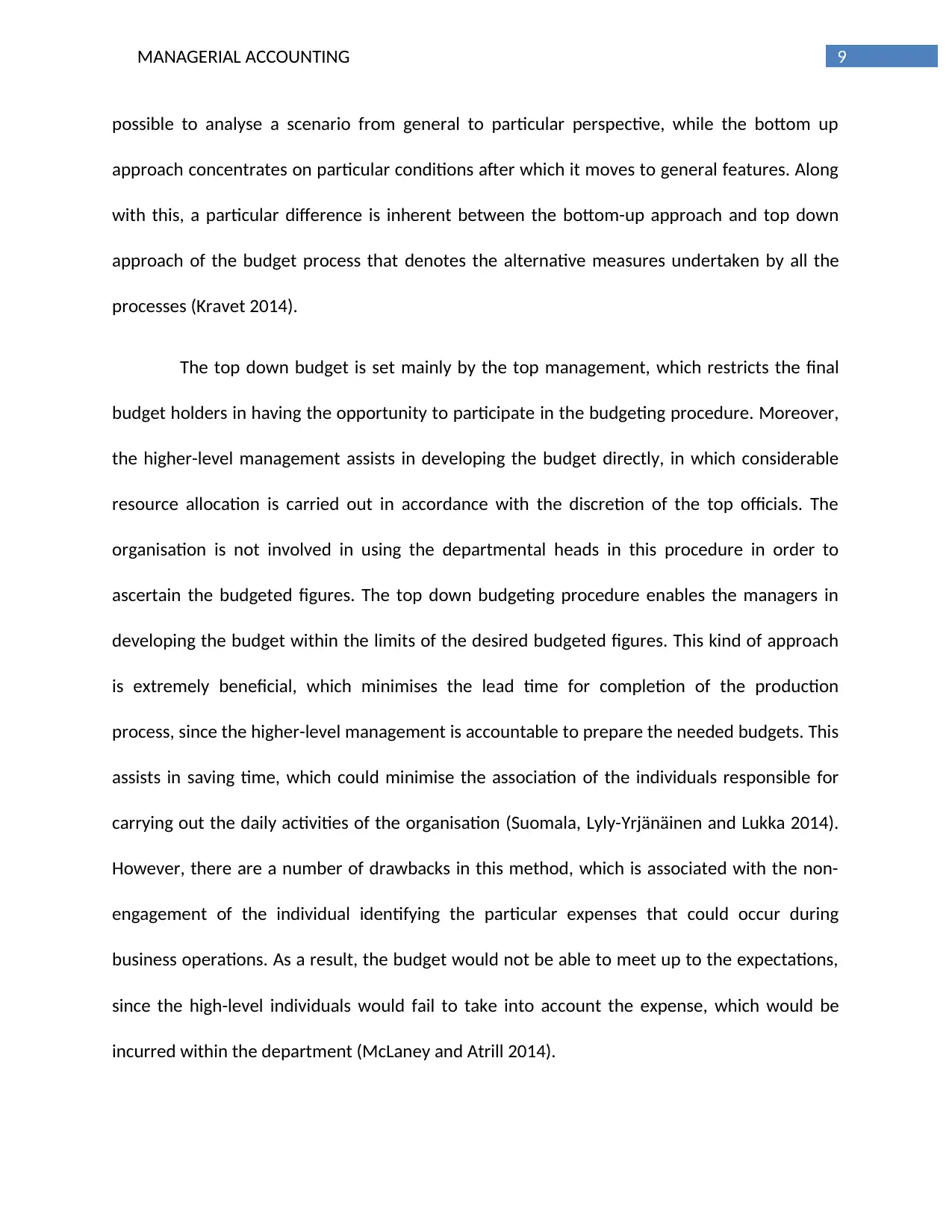
9MANAGERIAL ACCOUNTING
possible to analyse a scenario from general to particular perspective, while the bottom up
approach concentrates on particular conditions after which it moves to general features. Along
with this, a particular difference is inherent between the bottom-up approach and top down
approach of the budget process that denotes the alternative measures undertaken by all the
processes (Kravet 2014).
The top down budget is set mainly by the top management, which restricts the final
budget holders in having the opportunity to participate in the budgeting procedure. Moreover,
the higher-level management assists in developing the budget directly, in which considerable
resource allocation is carried out in accordance with the discretion of the top officials. The
organisation is not involved in using the departmental heads in this procedure in order to
ascertain the budgeted figures. The top down budgeting procedure enables the managers in
developing the budget within the limits of the desired budgeted figures. This kind of approach
is extremely beneficial, which minimises the lead time for completion of the production
process, since the higher-level management is accountable to prepare the needed budgets. This
assists in saving time, which could minimise the association of the individuals responsible for
carrying out the daily activities of the organisation (Suomala, Lyly-Yrjänäinen and Lukka 2014).
However, there are a number of drawbacks in this method, which is associated with the non-
engagement of the individual identifying the particular expenses that could occur during
business operations. As a result, the budget would not be able to meet up to the expectations,
since the high-level individuals would fail to take into account the expense, which would be
incurred within the department (McLaney and Atrill 2014).
possible to analyse a scenario from general to particular perspective, while the bottom up
approach concentrates on particular conditions after which it moves to general features. Along
with this, a particular difference is inherent between the bottom-up approach and top down
approach of the budget process that denotes the alternative measures undertaken by all the
processes (Kravet 2014).
The top down budget is set mainly by the top management, which restricts the final
budget holders in having the opportunity to participate in the budgeting procedure. Moreover,
the higher-level management assists in developing the budget directly, in which considerable
resource allocation is carried out in accordance with the discretion of the top officials. The
organisation is not involved in using the departmental heads in this procedure in order to
ascertain the budgeted figures. The top down budgeting procedure enables the managers in
developing the budget within the limits of the desired budgeted figures. This kind of approach
is extremely beneficial, which minimises the lead time for completion of the production
process, since the higher-level management is accountable to prepare the needed budgets. This
assists in saving time, which could minimise the association of the individuals responsible for
carrying out the daily activities of the organisation (Suomala, Lyly-Yrjänäinen and Lukka 2014).
However, there are a number of drawbacks in this method, which is associated with the non-
engagement of the individual identifying the particular expenses that could occur during
business operations. As a result, the budget would not be able to meet up to the expectations,
since the high-level individuals would fail to take into account the expense, which would be
incurred within the department (McLaney and Atrill 2014).
Paraphrase This Document
Need a fresh take? Get an instant paraphrase of this document with our AI Paraphraser
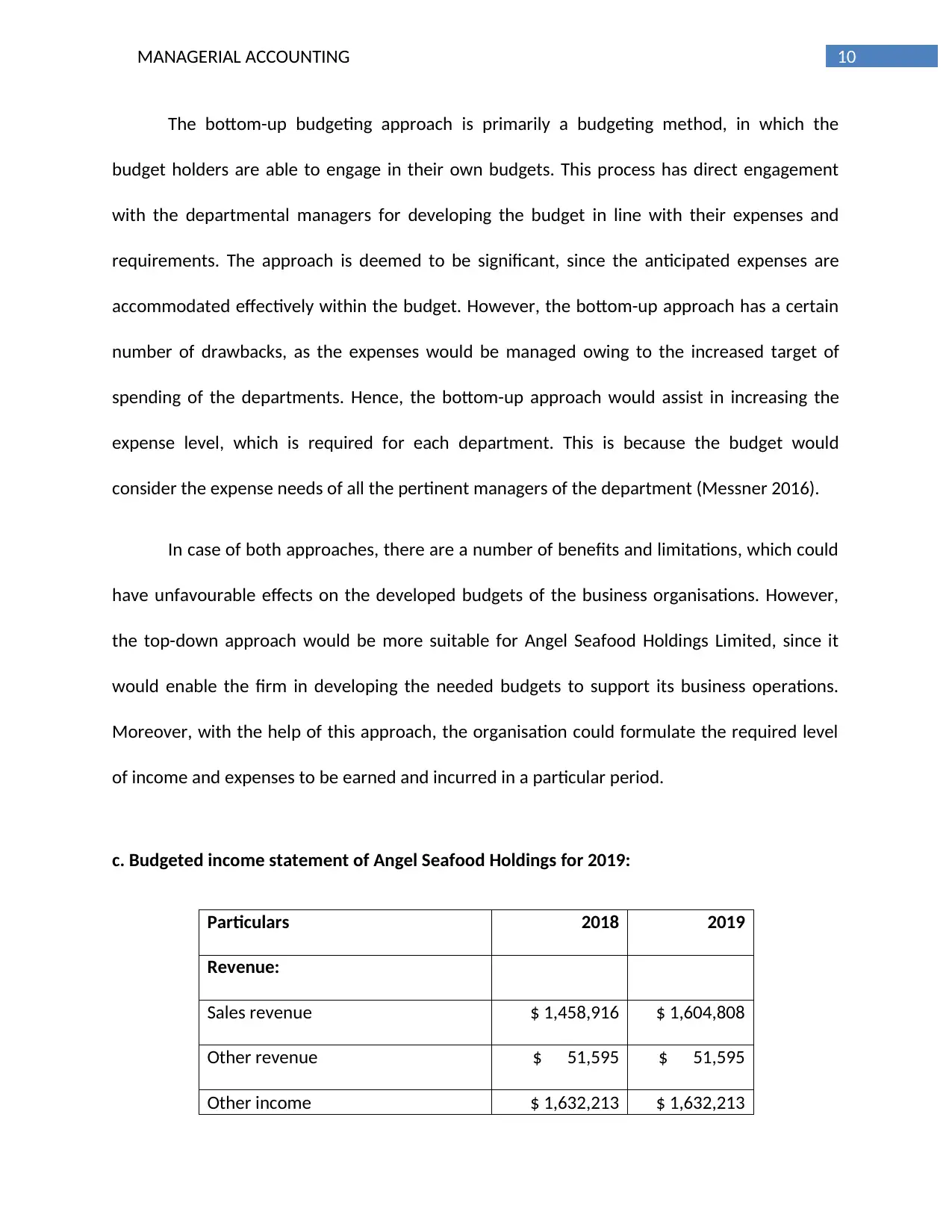
10MANAGERIAL ACCOUNTING
The bottom-up budgeting approach is primarily a budgeting method, in which the
budget holders are able to engage in their own budgets. This process has direct engagement
with the departmental managers for developing the budget in line with their expenses and
requirements. The approach is deemed to be significant, since the anticipated expenses are
accommodated effectively within the budget. However, the bottom-up approach has a certain
number of drawbacks, as the expenses would be managed owing to the increased target of
spending of the departments. Hence, the bottom-up approach would assist in increasing the
expense level, which is required for each department. This is because the budget would
consider the expense needs of all the pertinent managers of the department (Messner 2016).
In case of both approaches, there are a number of benefits and limitations, which could
have unfavourable effects on the developed budgets of the business organisations. However,
the top-down approach would be more suitable for Angel Seafood Holdings Limited, since it
would enable the firm in developing the needed budgets to support its business operations.
Moreover, with the help of this approach, the organisation could formulate the required level
of income and expenses to be earned and incurred in a particular period.
c. Budgeted income statement of Angel Seafood Holdings for 2019:
Particulars 2018 2019
Revenue:
Sales revenue $ 1,458,916 $ 1,604,808
Other revenue $ 51,595 $ 51,595
Other income $ 1,632,213 $ 1,632,213
The bottom-up budgeting approach is primarily a budgeting method, in which the
budget holders are able to engage in their own budgets. This process has direct engagement
with the departmental managers for developing the budget in line with their expenses and
requirements. The approach is deemed to be significant, since the anticipated expenses are
accommodated effectively within the budget. However, the bottom-up approach has a certain
number of drawbacks, as the expenses would be managed owing to the increased target of
spending of the departments. Hence, the bottom-up approach would assist in increasing the
expense level, which is required for each department. This is because the budget would
consider the expense needs of all the pertinent managers of the department (Messner 2016).
In case of both approaches, there are a number of benefits and limitations, which could
have unfavourable effects on the developed budgets of the business organisations. However,
the top-down approach would be more suitable for Angel Seafood Holdings Limited, since it
would enable the firm in developing the needed budgets to support its business operations.
Moreover, with the help of this approach, the organisation could formulate the required level
of income and expenses to be earned and incurred in a particular period.
c. Budgeted income statement of Angel Seafood Holdings for 2019:
Particulars 2018 2019
Revenue:
Sales revenue $ 1,458,916 $ 1,604,808
Other revenue $ 51,595 $ 51,595
Other income $ 1,632,213 $ 1,632,213
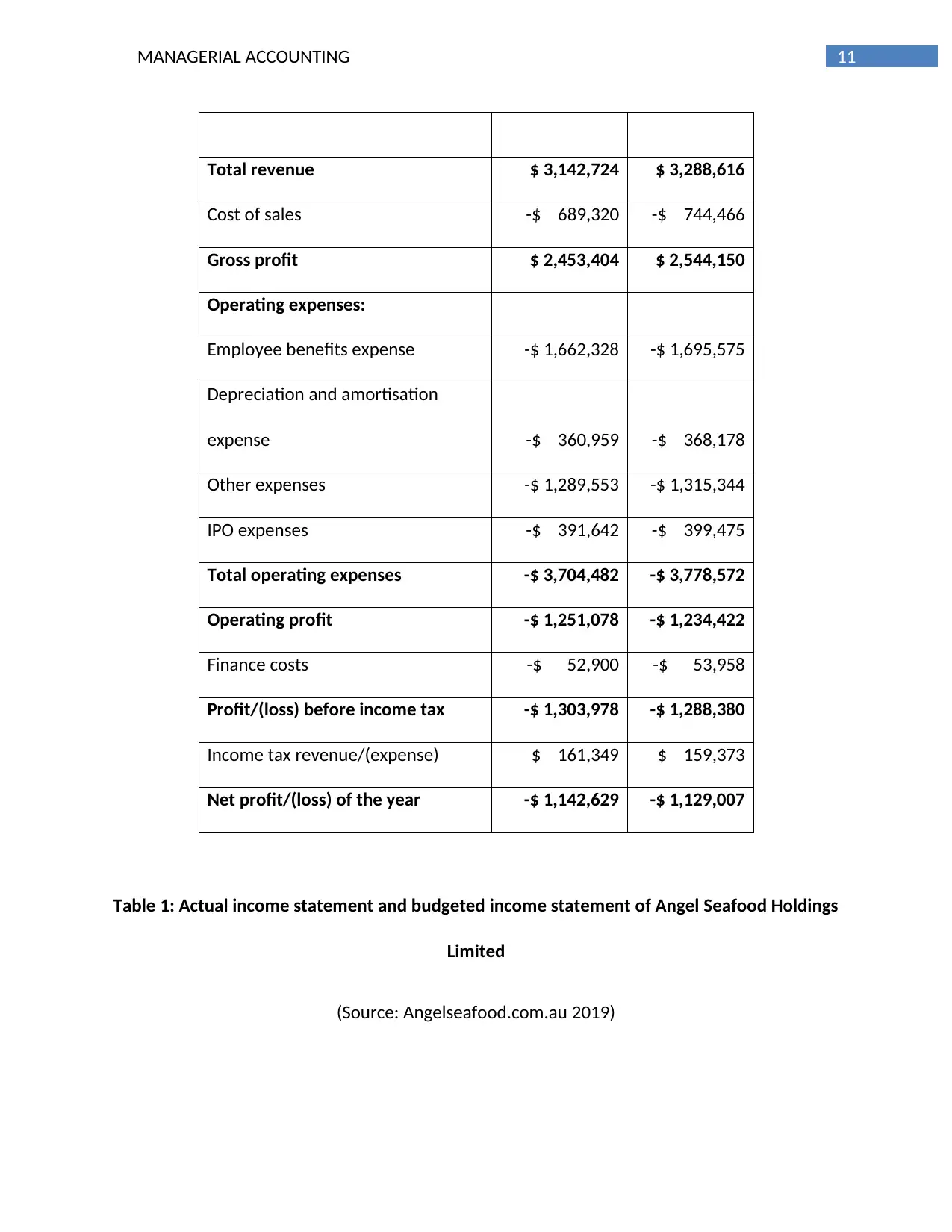
11MANAGERIAL ACCOUNTING
Total revenue $ 3,142,724 $ 3,288,616
Cost of sales -$ 689,320 -$ 744,466
Gross profit $ 2,453,404 $ 2,544,150
Operating expenses:
Employee benefits expense -$ 1,662,328 -$ 1,695,575
Depreciation and amortisation
expense -$ 360,959 -$ 368,178
Other expenses -$ 1,289,553 -$ 1,315,344
IPO expenses -$ 391,642 -$ 399,475
Total operating expenses -$ 3,704,482 -$ 3,778,572
Operating profit -$ 1,251,078 -$ 1,234,422
Finance costs -$ 52,900 -$ 53,958
Profit/(loss) before income tax -$ 1,303,978 -$ 1,288,380
Income tax revenue/(expense) $ 161,349 $ 159,373
Net profit/(loss) of the year -$ 1,142,629 -$ 1,129,007
Table 1: Actual income statement and budgeted income statement of Angel Seafood Holdings
Limited
(Source: Angelseafood.com.au 2019)
Total revenue $ 3,142,724 $ 3,288,616
Cost of sales -$ 689,320 -$ 744,466
Gross profit $ 2,453,404 $ 2,544,150
Operating expenses:
Employee benefits expense -$ 1,662,328 -$ 1,695,575
Depreciation and amortisation
expense -$ 360,959 -$ 368,178
Other expenses -$ 1,289,553 -$ 1,315,344
IPO expenses -$ 391,642 -$ 399,475
Total operating expenses -$ 3,704,482 -$ 3,778,572
Operating profit -$ 1,251,078 -$ 1,234,422
Finance costs -$ 52,900 -$ 53,958
Profit/(loss) before income tax -$ 1,303,978 -$ 1,288,380
Income tax revenue/(expense) $ 161,349 $ 159,373
Net profit/(loss) of the year -$ 1,142,629 -$ 1,129,007
Table 1: Actual income statement and budgeted income statement of Angel Seafood Holdings
Limited
(Source: Angelseafood.com.au 2019)
⊘ This is a preview!⊘
Do you want full access?
Subscribe today to unlock all pages.

Trusted by 1+ million students worldwide
1 out of 20
Related Documents
Your All-in-One AI-Powered Toolkit for Academic Success.
+13062052269
info@desklib.com
Available 24*7 on WhatsApp / Email
![[object Object]](/_next/static/media/star-bottom.7253800d.svg)
Unlock your academic potential
Copyright © 2020–2025 A2Z Services. All Rights Reserved. Developed and managed by ZUCOL.





